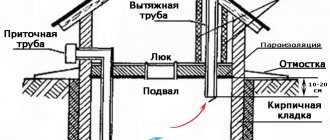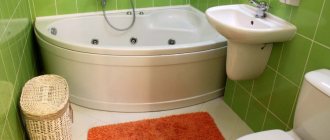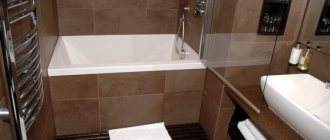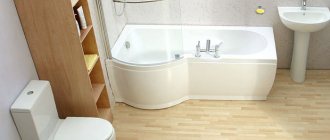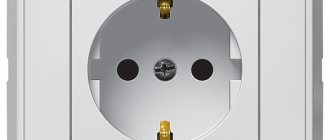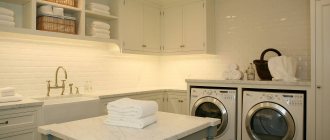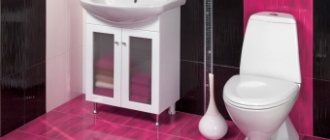Where does humidity come from in the bathroom?
This parameter depends on many factors:
- Time of year (humidity is higher in summer)
- Weather conditions outside (rain, fog)
- Living activities of residents (washing, cleaning, washing, drying wet things, cooking)
- Heating system efficiency
- Room ventilation
- Ventilation operation
- Window tightness
- Quality of finishing materials
Moisture on tiles
Often dampness depends on the floor of the apartment . Living on the ground floor is almost always associated with greater dampness than on higher floors. Dampness can “stretch” from the basement of a room due to such a physical phenomenon as capillary suction of moisture (from the soil through the foundation) along the walls. In addition, if trees or shrubs grow densely under the windows, they create additional humidity in the surrounding air . We all know the damp smell in the forest, in the park, in the country. In addition, trees interfere with ventilation. They can outshine the sun. And without direct sunlight, the room dries worse.
The bathroom is always damp from water treatments. The shower itself creates this environment. In addition, after washing, few people wipe the surface of the bathtub. The drops of water will, of course, dry themselves. But this moisture will hang in the air of the room . Water splashes often fall on walls, floors, and nearby objects. Wet rugs and towels are dried there.
Sometimes plumbing leaks add fuel to the fire (figuratively speaking). Dripping water from a tap, leaks or puddles under the bathtub, or a leaking toilet increase the water content in the surrounding atmosphere .
Good ventilation
In old houses and apartments, the ventilation grille is often so clogged with dust that there is no air circulation at all. The presence of traction can be checked using fire from a match or lighter. If the flame is bent by 45°C, then everything is fine with the ventilation; if not, it will have to be cleaned. To do this, remove the grille from the ventilation hole and wash it with any detergent.
Additionally, you can install a forced ventilation system with a power button. It is inserted instead of a grille and turns on when you need to quickly remove moisture, especially after fumes from a hot bath.
What is the normal humidity level for a bathroom?
GOST 30494-2011 establishes two types of humidity in residential premises: permissible and optimal. Permissible humidity in winter is 60%, and optimal is 35-40%. This parameter is not set in the kitchen, toilet, and bath areas. When the level rises above 70%, condensation occurs and the presence of dampness in the air is felt. A person's breathing becomes difficult under such conditions. Your health may worsen . Perspiration occurs on the skin even with little physical activity.
To determine the level of humidity in a room, special devices are used - moisture meters (hygrometers). There are several varieties of them:
- Hair device
- Film moisture meter
- Condensation meter
- Weight hygrometer
- Mechanical meter
- Electronic (room) hygrometer
However, a person can feel excessive dampness without special technical means. Often, higher moisture content in the air is accompanied by a characteristic musty smell.
Operating principle of the air handling unit
Exhaust ventilation allows you to control the humidity of the room, create the most comfortable microclimate in the room and ensure continuous circulation of air flow.
Air handling units (AHUs) are used to ventilate huge halls, shopping and entertainment centers, social facilities, and industrial premises. There are compact installations designed for apartments and rooms.
We recommend the product
Air handling unit Vents VUT 180 P5B EC A21
To order
Minimum temperature of transported air, °C: -25 | Depth, mm: 600 | Height, mm: 302 | Width, mm: 900 | Maximum pressure, Pa: 280 | Noise level, dB: 33 | Air consumption, m³/hour: 220 |
Why is humidity in the bathroom dangerous?
Mold is formed from excessive humidity.
Moisture and heat are suitable conditions for the development of microorganisms. Including harmful and hazardous to health. “Wet” air can contribute to the occurrence of such phenomena as :
- General malaise
- Runny nose
- Digestive disorders
- Bronchial diseases
- Headache
- Nausea
- Skin problems (dermatitis, allergies, cracks)
Children and the elderly are at risk. Children breathe more often. And newborns have weaker immunity than adults. The immune system is also at risk in older people. Chronic diseases may worsen.
High water content in the atmosphere of an apartment can have a detrimental effect on the health of pets . Especially those who live naturally in arid climates. Some types of flowers wither, “get sick” or die if the conditions of maintenance are violated. Including insufficient “dryness” in the room.
Damage to the premises
Excessive air humidity harms the materials used to decorate the room.
Furniture (cabinets, shelves, stands) made of wood or chipboard can swell, crack, and become deformed. Although bathroom furniture is coated with special moisture-resistant paints, it still becomes unusable from constant prolonged exposure to dampness.
Dampness promotes peeling of plaster . Promotes rapid deterioration of paintwork on walls and ceilings.
Parasites, insects
Silverfish love dark and damp rooms.
Parasites, insects and other creatures that are unpleasant to humans love moist habitats. Most pests or parasites usually appear in the bathroom or kitchen.
In addition to being an unpleasant neighborhood and unaesthetic appearance, such guests can be carriers of infections . Often the appearance of a snow-white bathtub or sink is spoiled by excrement. They can spread to other rooms if left unchecked.
The most common uninvited guests are silverfish, woodlice, cockroaches, centipedes, house flies, midges, and flycatchers. The list doesn't end there.
Mold
Mold is the most insidious enemy of any room or apartment . Appears as spots or dots of black, dirty yellow or dirty green. It forms most often in corners, on walls, on ceilings, between tile seams, and in the area of cracks. Mold is often invisible under finishing materials. But when it comes out, there is a need to eliminate and repair it .
Toxins and spores released by mold spread throughout the apartment through the air. By inhaling them, a person puts his health at risk. The effects of mold on humans can include:
- Bad feeling
- Intestinal disorders
- Weakening of the immune system
- Exacerbation of chronic diseases
- Upper respiratory tract diseases
- Allergy
A large amount of mold in a room creates a putrid odor.
The main reasons why walls become damp
To find out why a wall gets wet, you need to understand that there are obvious and hidden factors. The reasons for the problem are:
The wall in a private house becomes damp also because the balcony slabs do not connect well to the base. Improper vapor barrier also leads to condensation on the pipes.
Recent renovation
After carrying out repairs using plaster mixtures or putties, the problem of wet walls arises. These finishing materials contain a large amount of water, which is absorbed by the base. This phenomenon is normal, and the moisture remains inside the walls for some time. The problem is also caused by poor ventilation of the room during renovation work.
If in this case the wall gets wet, the problem goes away on its own within a week. You can speed up the process if you constantly ventilate the room. The use of heaters or other technical devices is not always permitted.
External moisture
If a wall becomes damp, the reason for this is often insufficient waterproofing. Moisture can seep through the smallest cracks, accumulating inside the base. The walls in a panel house get wet more often than in buildings made of other materials. The weak point here is the seams between the slabs. If the construction technology is violated, their depressurization occurs.
If the walls of a house on the upper floors become wet, this is caused by poor quality of the drainage system, improper installation of the roof covering or insufficient level of roof waterproofing. Most often, moisture spots can be seen in spring and autumn, with the arrival of the rainy season.
Methods for dealing with moisture
Eliminating excess moisture in a bathroom or toilet requires an integrated approach. Often, financial investments are needed to eliminate the cause. But in order to avoid harm to health and not to do frequent renovations in the bathroom, it is advisable to think through a strategy for dealing with moisture in advance.
Forced ventilation
Forced ventilation
Usually the bathroom is equipped with a standard ventilation system. Which, unfortunately, is sometimes not enough for the necessary air circulation. Often the ventilation shaft is blocked by debris. Or “enterprising” neighbors, in the process of renovating the apartment, disrupted its functioning.
To eliminate this problem , there is a technical solution such as forced ventilation . This is an exhaust fan that is installed on the ventilation opening in the wall. The fan is connected to the network. It can be turned on and off as needed.
Warm floor
evaporate excess water from the floor using heated floors . It is better to make such a floor right away, during the renovation of the bathroom. These are special cables or heating mats that are laid as required under the tiles on the floor. These elements are waterproof in case of water leaks. Safe to use. The regulator (switch) is usually connected to the next room. If necessary, home owners can turn it on and regulate the floor temperature.
Ventilation
A method that does not require investment. Just open the bathroom doors and let the room ventilate naturally . Disadvantages of this method:
- An open door into the corridor may interfere with the passage of residents
- Residents may forget to close the door after taking a shower/bath.
- Pets or children will have access to the bathroom (so all household chemicals must be hidden)
Bathroom window
Ordinary apartments rarely have such an “attraction” as a window in the bathroom/toilet. It is almost impossible to do it yourself in an apartment. It is better to consider the possibility of installing a window at the renovation planning stage. It won’t be possible to break down a solid wall, but you can make a window from the bathtub into the kitchen . Or at the time of drawing up a drawing of a future private house, cottage, put a window opening in it. The window will provide an opportunity to ventilate the bathroom naturally . Direct sunlight from the street will create uncomfortable conditions for parasites. They will most likely never start in such a room.
Drying clothes in another room
Drying clothes on lines over the bathtub is a bad idea. Although it has its advantages. Water from poorly wrung clothes will drip directly into the bathtub. Linen will not be visible. But this drying method has more disadvantages, because... This process increases the concentration of moisture in the air . It is recommended to dry washed clothes either on the balcony or in a room near a heating radiator or an open window. There are floor dryers for this.
Elimination of leaking pipes and taps
Check all connections, taps, hoses for leaks. Don't be lazy, look under the bathroom . Perhaps there is a puddle hidden there from your eyes. Check the toilet. Especially the place where it connects to the sewer pipe. It is recommended to keep the toilet lid closed. So that there is also no evaporation of moisture from there.
Technical means
There are dehumidifiers designed specifically for domestic use . Installed in a room where you need to get rid of excess dampness. Available in various versions. There are wall and floor dehumidifiers. They vary in size, noise, and performance. Based on the operating principle, they are divided into adsorbent, condensation and Pelte technology. This is a broad topic that we will not delve into in this article.
However, the high cost of dehumidifiers often push apartment residents to use simpler devices. For example, bring a room fan to the room you want to dry. The fan creates air currents, moisture evaporates faster from surfaces. And instead of a warm floor, a regular heater will do. By raising the air temperature, it helps dry the bathroom quickly. There are heaters with fans. Directed warm air from them will quickly dry the damp corners of the room.
Household air conditioners have the property of not only cooling (or heating) the air, but also drying it. It is not without reason that it is recommended to turn on the air conditioning to remove fogging from your car windows. The operating principle of home and car air conditioners is the same. But, you must admit, it is extremely rare to find “conder” in the shower. The method is more suitable, for example, for the kitchen.
Where to contact
If all possible options for eliminating dampness do not help, then you need to write and submit a statement to the management company. In 2021, it will be drawn up in writing and in two copies. The paper should contain detailed information about when the corners or walls began to get wet, and an exact indication of the location.
ATTENTION! After submitting your application, it is important to ensure that it is recorded. The applicant must keep one copy with a mark.
The next action of the management company should be to send a technician to inspect the residential premises, based on the results of which a report on the presence of dampness and the reasons for its occurrence will be drawn up. The apartment owner must request a copy of this document.
As soon as the act is drawn up, the management company must decide on the option for repair work, as well as the time frame by which it will be completed. It is advisable for the apartment owner to take a copy of each document. If the repairs are not carried out or the period is significantly delayed, then these copies can be contacted with the relevant authorities.
Sample application to the Criminal Code
Sample complaint to the Housing Inspectorate
Then you can file a complaint with the housing inspectorate. It can also be submitted collectively, where all participants sign and the date is indicated. Such a complaint is considered within 30 working days. However, practice shows that it is considered in a shorter period of time. Most often this happens within 14 days.
Sample application to the Prosecutor's Office
The next authority you can subsequently contact is the prosecutor's office. A complaint to this body must be made in free form. As a rule, it is filled out in an official business style.
Obscene language and the use of jargon are unacceptable. And also you shouldn’t rate the problem. You need to restrain your emotionality. The government agency has the right to leave such applications without consideration.
Another important point is that errors, whether punctuation or spelling, should not in any way affect the acceptance of the complaint. At the end there is a signature and date.
Sample application to the Court
The last authority to which you can turn is the court. It should finally resolve your problem. But most often it all ends in the previous organs.
Common mistakes in dealing with excess humidity
- Apartment owners rely on ventilation. But weak air draft may not cope with high levels of humidity.
- Incorrectly installed forced ventilation system.
- Leaks in the water supply system, at the connections of plumbing equipment, and faulty faucets have not been eliminated.
- Poorly chosen finishing materials coupled with a lack of waterproofing of the room. As a result, the walls, ceiling, and floor absorb moisture. Over time they give it away.
- Cracks, holes or poor seals between the walls and sides of the bathtub. As a result, drops of water accumulate behind the bathtub or under it.
- The small size or ineffective operation of the heated towel rail prevents it from drying wet towels. Towels release moisture into the surrounding air.
- The bathroom or toilet is never ventilated.
- The bath mat is never or rarely dried
- The walls and floors of apartments on low floors absorb moisture from the soil through the foundation. The walls release this moisture into the atmosphere.
Antiseptics
The ability to resist fungi and bacteria is another useful property, in addition to moisture resistance, that materials and objects for the bathroom should have: for example, stainless steel and plastic are unattractive to infection on their own. Many paints and tile grouts have antiseptic properties - choose them. Areas of the floor, ceiling and walls that are especially susceptible to infection, as well as the inside of the shower stall, can be treated with a special antiseptic composition.
Siphon cleaning
The siphon under the sink, bathtub or shower is a good place for bacteria to grow.
Hair, particles of cosmetics, and fat settle in it, and then cool and literally stick to the walls. This is an excellent environment for the growth of bacteria, and gradually the mass of sewage only becomes larger, causing not only an unpleasant odor, but also complicating the outflow of wastewater. If the cause of the unpleasant odor lies precisely in the siphon, then the procedure will be as follows:
- remove the siphon and clean it of adhering deposits. It is appropriate to place a basin or bucket under the siphon so as not to stain anything;
- wash the siphon walls with dishwashing detergent;
- install a clean siphon in place, ensuring the tightness of all joints;
- Use drain cleaners regularly to prevent sediment from accumulating there.
The siphon (hydraulic seal) takes on an important function in terms of protection against odors. Thanks to the existence of a water plug, stench simply cannot get into the apartment. Siphons come in bottle, tubular and corrugated types. The bottle type is ideal for the sink; it is easy to install. The cheapest option is a corrugated siphon.
